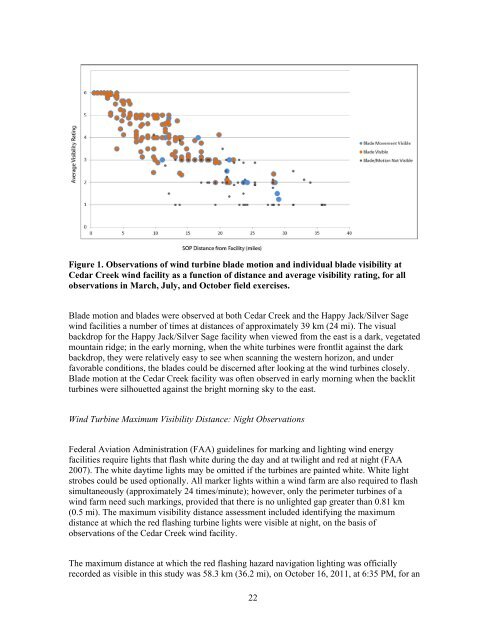Wind Turbine Visibility and Visual Impact Threshold Distances in ...
Wind Turbine Visibility and Visual Impact Threshold Distances in ...
Wind Turbine Visibility and Visual Impact Threshold Distances in ...
You also want an ePaper? Increase the reach of your titles
YUMPU automatically turns print PDFs into web optimized ePapers that Google loves.
Figure 1. Observations of w<strong>in</strong>d turb<strong>in</strong>e blade motion <strong>and</strong> <strong>in</strong>dividual blade visibility at<br />
Cedar Creek w<strong>in</strong>d facility as a function of distance <strong>and</strong> average visibility rat<strong>in</strong>g, for all<br />
observations <strong>in</strong> March, July, <strong>and</strong> October field exercises.<br />
Blade motion <strong>and</strong> blades were observed at both Cedar Creek <strong>and</strong> the Happy Jack/Silver Sage<br />
w<strong>in</strong>d facilities a number of times at distances of approximately 39 km (24 mi). The visual<br />
backdrop for the Happy Jack/Silver Sage facility when viewed from the east is a dark, vegetated<br />
mounta<strong>in</strong> ridge; <strong>in</strong> the early morn<strong>in</strong>g, when the white turb<strong>in</strong>es were frontlit aga<strong>in</strong>st the dark<br />
backdrop, they were relatively easy to see when scann<strong>in</strong>g the western horizon, <strong>and</strong> under<br />
favorable conditions, the blades could be discerned after look<strong>in</strong>g at the w<strong>in</strong>d turb<strong>in</strong>es closely.<br />
Blade motion at the Cedar Creek facility was often observed <strong>in</strong> early morn<strong>in</strong>g when the backlit<br />
turb<strong>in</strong>es were silhouetted aga<strong>in</strong>st the bright morn<strong>in</strong>g sky to the east.<br />
<strong>W<strong>in</strong>d</strong> <strong>Turb<strong>in</strong>e</strong> Maximum <strong>Visibility</strong> Distance: Night Observations<br />
Federal Aviation Adm<strong>in</strong>istration (FAA) guidel<strong>in</strong>es for mark<strong>in</strong>g <strong>and</strong> light<strong>in</strong>g w<strong>in</strong>d energy<br />
facilities require lights that flash white dur<strong>in</strong>g the day <strong>and</strong> at twilight <strong>and</strong> red at night (FAA<br />
2007). The white daytime lights may be omitted if the turb<strong>in</strong>es are pa<strong>in</strong>ted white. White light<br />
strobes could be used optionally. All marker lights with<strong>in</strong> a w<strong>in</strong>d farm are also required to flash<br />
simultaneously (approximately 24 times/m<strong>in</strong>ute); however, only the perimeter turb<strong>in</strong>es of a<br />
w<strong>in</strong>d farm need such mark<strong>in</strong>gs, provided that there is no unlighted gap greater than 0.81 km<br />
(0.5 mi). The maximum visibility distance assessment <strong>in</strong>cluded identify<strong>in</strong>g the maximum<br />
distance at which the red flash<strong>in</strong>g turb<strong>in</strong>e lights were visible at night, on the basis of<br />
observations of the Cedar Creek w<strong>in</strong>d facility.<br />
The maximum distance at which the red flash<strong>in</strong>g hazard navigation light<strong>in</strong>g was officially<br />
recorded as visible <strong>in</strong> this study was 58.3 km (36.2 mi), on October 16, 2011, at 6:35 PM, for an<br />
22


